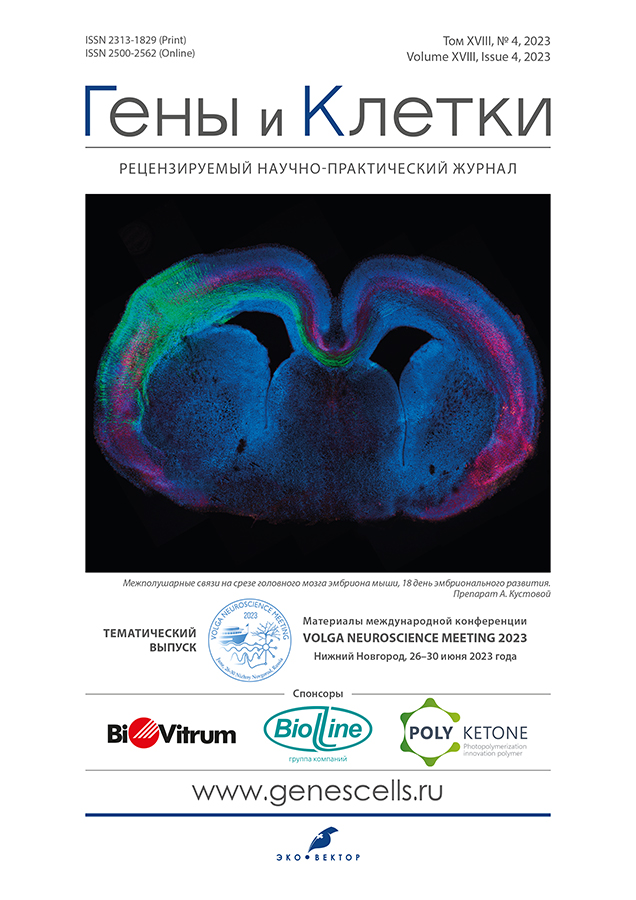Энграмма памяти о комлексном сигнале в мозге мышей: различные нейрональные ансамбли кодируют комплексный условный стимул и его индивидуальные компоненты
- Авторы: Ивашкина О.И.1, Торопова К.А.1, Анохин К.В.1,2
-
Учреждения:
- Московский государственный университет им. М.В. Ломоносова
- Научно-исследовательский институт нормальной физиологии им. П.К. Анохина
- Выпуск: Том 18, № 4 (2023)
- Страницы: 710-712
- Раздел: Материалы конференции
- Статья получена: 13.11.2023
- Статья одобрена: 16.11.2023
- Статья опубликована: 15.12.2023
- URL: https://genescells.ru/2313-1829/article/view/623248
- DOI: https://doi.org/10.17816/gc623248
- ID: 623248
Цитировать
Полный текст
Аннотация
Естественные ситуации обучения обычно включают комплексные стимулы, состоящие из нескольких сенсорных модальностей. Элементные теории обучения предполагают, что каждый компонент комплексного сигнала кодируется и ассоциируется отдельно. Конфигуральные теории предсказывают, что репрезентация полного комплексного сигнала формируется и ассоциируется со вторым событием. Нами была разработана модель условно-рефлекторного замирания на комплексный условный сигнал (КУС) или его отдельные световой и звуковой компоненты у мышей. Данная модель была использована, чтобы проверить рассмотренные выше альтернативные теории. Нами была исследована динамика памяти о комплексном условном сигнале и его компонентах. Мы обнаружили, что память о данных компонентах созревает в течение различных промежутков времени после обучения: память о звуковом условном стимуле и звуковом компоненте КУС проявляется сразу после обучения, а память о световом условном стимуле и световом компоненте КУС дозревает в течение 3 дней. При этом память о КУС, его компонентах и дискретных условных стимулах хранится длительно, вплоть до 1 месяца. Сходная диссоциация была обнаружена в экспериментах по угашению. Было показано, что при начале процедуры угашения через 1 день после обучения угашение памяти об 1 компоненте КУС не влияет на память о другом компоненте КУС. При начале процедуры угашения через 7 дней после обучения, когда память полностью дозрела, угашение памяти об 1 компоненте КУС также приводит к угашению памяти о другом компоненте. Далее нами был проведён с-Fos имиджинг активности клеток в фронтальной, прелимбической, цингулярной, ретросплениальной, париетальной, первичной и вторичной зрительных, первичной и вторичной слуховых областях неокортекса, а также в гиппокампе и миндалине после обучения на полный комплексный сигнал или его компоненты. Было обнаружено, что обучение на комплексный сигнал и дискретные сигналы вызывают различные паттерны активации неокортекса — прелимбическая и фронтальная ассоциативная области коры активировались при обучении на комплексный, но не на дискретные сигналы. Мы показали, что только извлечение памяти о полном комплексном сигнале, но не о его компонентах активировало париетальную, первичную зрительную область и медиолатеральную область вторичной зрительной коры, а также область СА1 гиппокампа. Нами был проведён in vivo двухфотонный имиджинг вызванной реактивацией памяти экспрессии с-Fos в париетальной коре трансгенных мышей линии fos-EGFP. Мы обнаружили, что существуют по крайней мере три популяции нейронов с различной специфичностью ответов на комплексный сигнал и его компоненты. Таким образом, наши данные свидетельствуют о том, что комплексные сигналы могут иметь как интегральные, так и элементные репрезентации. Эти репрезентации могут использоваться в поведении независимо, а также иметь различную динамику в долговременной памяти.
Полный текст
Естественные ситуации обучения обычно включают комплексные стимулы, состоящие из нескольких сенсорных модальностей. Элементные теории обучения предполагают, что каждый компонент комплексного сигнала кодируется и ассоциируется отдельно. Конфигуральные теории предсказывают, что репрезентация полного комплексного сигнала формируется и ассоциируется со вторым событием. Нами была разработана модель условно-рефлекторного замирания на комплексный условный сигнал (КУС) или его отдельные световой и звуковой компоненты у мышей. Данная модель была использована, чтобы проверить рассмотренные выше альтернативные теории. Нами была исследована динамика памяти о комплексном условном сигнале и его компонентах. Мы обнаружили, что память о данных компонентах созревает в течение различных промежутков времени после обучения: память о звуковом условном стимуле и звуковом компоненте КУС проявляется сразу после обучения, а память о световом условном стимуле и световом компоненте КУС дозревает в течение 3 дней. При этом память о КУС, его компонентах и дискретных условных стимулах хранится длительно, вплоть до 1 месяца. Сходная диссоциация была обнаружена в экспериментах по угашению. Было показано, что при начале процедуры угашения через 1 день после обучения угашение памяти об 1 компоненте КУС не влияет на память о другом компоненте КУС. При начале процедуры угашения через 7 дней после обучения, когда память полностью дозрела, угашение памяти об 1 компоненте КУС также приводит к угашению памяти о другом компоненте. Далее нами был проведён с-Fos имиджинг активности клеток в фронтальной, прелимбической, цингулярной, ретросплениальной, париетальной, первичной и вторичной зрительных, первичной и вторичной слуховых областях неокортекса, а также в гиппокампе и миндалине после обучения на полный комплексный сигнал или его компоненты. Было обнаружено, что обучение на комплексный сигнал и дискретные сигналы вызывают различные паттерны активации неокортекса — прелимбическая и фронтальная ассоциативная области коры активировались при обучении на комплексный, но не на дискретные сигналы. Мы показали, что только извлечение памяти о полном комплексном сигнале, но не о его компонентах активировало париетальную, первичную зрительную область и медиолатеральную область вторичной зрительной коры, а также область СА1 гиппокампа. Нами был проведён in vivo двухфотонный имиджинг вызванной реактивацией памяти экспрессии с-Fos в париетальной коре трансгенных мышей линии fos-EGFP. Мы обнаружили, что существуют по крайней мере три популяции нейронов с различной специфичностью ответов на комплексный сигнал и его компоненты. Таким образом, наши данные свидетельствуют о том, что комплексные сигналы могут иметь как интегральные, так и элементные репрезентации. Эти репрезентации могут использоваться в поведении независимо, а также иметь различную динамику в долговременной памяти.
ДОПОЛНИТЕЛЬНАЯ ИНФОРМАЦИЯ
Источник финансирования. Исследование выполнено при финансовой поддержке Некоммерческого Фонда развития науки и образования «Интеллект», Междисциплинарной научно-образовательной школы МГУ им. М.В. Ломоносова «Мозг, когнитивные системы, искусственный интеллект» и гранта РНФ № 23-78-00010.
Об авторах
О. И. Ивашкина
Московский государственный университет им. М.В. Ломоносова
Автор, ответственный за переписку.
Email: oivashkina@gmail.com
Россия, Москва
К. А. Торопова
Московский государственный университет им. М.В. Ломоносова
Email: oivashkina@gmail.com
Россия, Москва
К. В. Анохин
Московский государственный университет им. М.В. Ломоносова; Научно-исследовательский институт нормальной физиологии им. П.К. Анохина
Email: oivashkina@gmail.com
Россия, Москва; Москва
Список литературы
Дополнительные файлы











